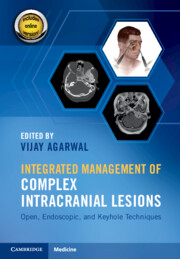Book contents
- Integrated Management of Complex Intracranial Lesions
- Integrated Management of Complex Intracranial Lesions
- Copyright page
- Dedication
- Contents
- Contributors
- Foreword
- Section I Endoscopic Endonasal (EN) Combined Approaches
- Chapter 1 Combined Endonasal Transethmoidal, Transcribriform, and Endoscope-Assisted Supraorbital Craniotomy
- Chapter 2 Combined Endonasal and Transorbital Approach
- Chapter 3 Combined Endonasal and Transoral Endoscopic Approach to the Craniovertebral Junction
- Chapter 4 Combined Endoscopic Endonasal and Transcervical Approach
- Chapter 5 Combined Endoscopic Endonasal and Transcranial Approach to Complex Intracranial Lesions
- Section II Open Combined Approaches
- Index
- References
Chapter 5 - Combined Endoscopic Endonasal and Transcranial Approach to Complex Intracranial Lesions
from Section I - Endoscopic Endonasal (EN) Combined Approaches
Published online by Cambridge University Press: 05 October 2021
- Integrated Management of Complex Intracranial Lesions
- Integrated Management of Complex Intracranial Lesions
- Copyright page
- Dedication
- Contents
- Contributors
- Foreword
- Section I Endoscopic Endonasal (EN) Combined Approaches
- Chapter 1 Combined Endonasal Transethmoidal, Transcribriform, and Endoscope-Assisted Supraorbital Craniotomy
- Chapter 2 Combined Endonasal and Transorbital Approach
- Chapter 3 Combined Endonasal and Transoral Endoscopic Approach to the Craniovertebral Junction
- Chapter 4 Combined Endoscopic Endonasal and Transcervical Approach
- Chapter 5 Combined Endoscopic Endonasal and Transcranial Approach to Complex Intracranial Lesions
- Section II Open Combined Approaches
- Index
- References
Summary
One of the most common combined approaches to skull base tumors includes a transcranial and endoscopic endonasal approach to the anterior and central skull base. Independently these are two common operative procedures employed in the modern treatment of skull base lesions, and have been favored over other historical approaches such as craniofacial, transfacial, and midface degloving due to decreased morbidity and mortality. When these approaches are combined, they add a new solution to the neurosurgeon’s armamentarium, providing a relatively minimally invasive approach with maximal resection in indicated complex lesions.
- Type
- Chapter
- Information
- Integrated Management of Complex Intracranial LesionsOpen, Endoscopic, and Keyhole Techniques, pp. 35 - 50Publisher: Cambridge University PressPrint publication year: 2021

